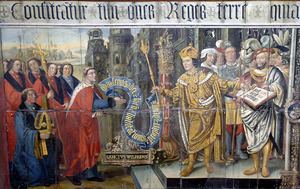Name Lambert Barnard | ||
 | ||
Lambert Barnard, also known as Lambert Bernardi (c.1485–1567) was an English Renaissance painter.
Contents

Origins and Style

Barnard's place of birth is not known, but he is now believed to be of English origin. All of his extant works can be found in and around Chichester. His long-lived son, Anthony Barnard (1513- 1619), grandson, Lambert, and two descendant generations of painter (also named Lambert), followed him in the city.
Barnard worked in dry fresco and with oil on board. His style is characterized by the use of rich colors, heavy black outline, and lavish gilding. His work has often suffered from heavy over-painting that has obscured the delicacy of his hand, but it is still possible to see he had a knowledge of contemporary European practice. This hints that he might have served an apprenticeship with a Franco/Flemish workshop before c.1513, entering into the service of Robert Sherborn, Bishop of Chichester from 1508 to 1536. Barnard maintained a small workshop with an apprentice boy, John Foster, and his son, Anthony Barnard, who may also have worked alongside his father in the cathedral on his last commission. Records indicate that in 1533, at Bishop Sherborn's request, the Dean and Chapter of Chichester Cathedral granted Barnard an annual payment in recognition of "his long and good service." Following the bishop's death in 1536, Barnard remained in his tenement in East Street, Chichester, living on his annuity, occasionally updating his work on the portraits of kings and bishops, and making repairs to other works in the cathedral.
Works
Over the next twenty years in collaboration with the bishop, Barnard executed several works, the foliage and heraldry themed vaults of Chichester Cathedral (from c.1513); a domestic wall painting in the Vicar's Close in Chichester; a series of The Nine Ladies Worthy, or Heroines of Antiquity referred to as The Amberley Panels (c. 1526) for one of the bishop's residences, Amberley Castle; the Italianate heraldic ceiling of the Tudor Room of the Bishop's Palace in Chichester (c.1524-1528) and his most important work, The Chichester Cathedral Charter Paintings(1533). This latter is a large scheme originally displayed in the South Transept of Chichester Cathedral and depicts its early foundation at Selsey The West Saxon King Caedwalla Granting the See of Selsey to St Wilfrid and secondly, its continuation at Chichester Henry VIII Confirming to Bishop Sherborn the Royal Protection of Chichester Cathedral. These two conjoined panels are framed above an attached series of roundels of portrait heads of the early Kings and Queens of England and hang in the South Transept. Following the collapse of the cathedral spire in 1861 the rest of the scheme, a Catalogus Episcopi, painted roundels of the Bishops of Selsey and Chichester, was moved to the North Transept. In its entirety it also offers a commentary on the historic authority of the Roman Catholic Church in England and the political events leading up to the changes of the Reformation. The recent dating of this scheme at 1533 makes it an original statement hugely important to the history of English art.
Other Works
Barnard appears to have spent his working life within Chichester and its immediate area. However, around 1532, he was employed by Sherborn's colleague and executor Thomas West, 9th Baron De La Warr, to decorate the vaults of nearby Boxgrove Priory with West's family heraldry; he may also have been the "Mr. Barnard" responsible in 1545 for supplying a now lost altarpiece of the Conception for the high altar of St Margaret's Church, Westminster. There is nothing in his style to indicate, as has been suggested, that he was the author of eight of the miniatures of John Lydgates' Troy Book and Siege of Troy, British Library Royal MS 8 D II.
As English paintings of the early sixteenth century, produced outside the ambiance of the royal court, Lambert Barnard's work is a very rare survival and should be seen as an important indicator of English regional painting at that time.
